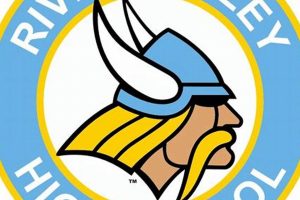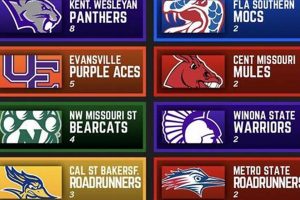Colleges and universities competing at the NCAA Division III level offer student-athletes the opportunity to play competitive basketball while prioritizing academics. These institutions typically feature smaller student bodies and emphasize a balance between athletic pursuits and rigorous academic programs. For example, a student might major in biology while also playing point guard for their school’s team, demonstrating the dual focus encouraged within this division.
This commitment to a balanced experience offers several advantages. Smaller class sizes often lead to closer student-faculty relationships and more individualized attention. The emphasis on academic achievement prepares students for diverse career paths, whether or not they pursue professional basketball. Historically, Division III has fostered a strong sense of community and sportsmanship, promoting an environment where athletic competition complements personal growth and educational development.
This article will further explore the landscape of Division III women’s basketball, examining topics such as recruiting, academic standards, athletic scholarships, and the overall student-athlete experience.
Tips for Prospective Student-Athletes
Navigating the college recruitment process requires careful planning and consideration. These tips offer guidance for those interested in competing at the Division III level.
Tip 1: Academic Excellence is Paramount: Strong academic performance is crucial. Maintaining a high GPA and challenging oneself with rigorous coursework demonstrates preparedness for the academic demands of these institutions. For example, taking advanced placement courses or participating in academic enrichment programs can showcase commitment to learning.
Tip 2: Proactive Communication with Coaches: Reach out to coaches directly. Express genuine interest in the program and highlight relevant skills and accomplishments. Sending personalized emails, attending college showcases, and participating in summer camps can facilitate connections with coaching staff.
Tip 3: Showcase Athletic Abilities: Create a highlight reel showcasing athletic strengths and skills. Share game film and performance statistics with coaches to demonstrate competitive abilities. Participating in AAU tournaments and attending college ID camps can provide opportunities for exposure.
Tip 4: Research Institutions Thoroughly: Explore various colleges and universities to find the right fit. Consider factors such as academic programs, campus culture, coaching philosophy, and team dynamics. Visiting campuses and attending games can provide valuable insights.
Tip 5: Understand Financial Aid Opportunities: While athletic scholarships are not offered at this level, explore need-based financial aid, academic scholarships, and grants. Contact the financial aid offices of prospective institutions for detailed information.
Tip 6: Time Management is Essential: Develop strong time management skills to balance academic responsibilities with athletic commitments. Effective planning and organization are crucial for success both on and off the court.
Tip 7: Character and Leadership Matter: Demonstrate strong character and leadership qualities. Coaches value student-athletes who exhibit sportsmanship, teamwork, and a positive attitude. Participation in community service and extracurricular activities can showcase these attributes.
By following these guidelines, prospective student-athletes can effectively navigate the recruitment process and increase their chances of finding the right academic and athletic environment.
This information provides a foundation for making informed decisions about pursuing collegiate athletics. The concluding section will offer final thoughts and resources for further exploration.
1. Academics
Academic pursuits form the cornerstone of the Division III student-athlete experience. Institutions prioritize intellectual growth alongside athletic competition. This emphasis on academics stems from the divisional philosophy that student-athletes are students first. Rigorous academic standards challenge individuals to develop critical thinking, problem-solving, and time-management skills. For example, a student-athlete might pursue a demanding major in engineering while also competing on the basketball court, demonstrating the commitment to academic excellence within this division. This dual focus prepares individuals for diverse career paths after graduation, regardless of whether they pursue professional sports.
The benefits of this academic focus extend beyond career preparation. Smaller class sizes and close student-faculty relationships foster a supportive learning environment. Professors often serve as mentors, providing individualized guidance and support. This personalized attention contributes to a well-rounded education, allowing student-athletes to explore intellectual passions and develop a strong sense of academic identity. The integration of academics and athletics fosters a culture of holistic development, enriching the overall college experience. For instance, a student-athlete majoring in history might conduct research on the history of women’s basketball, connecting their academic interests with their athletic pursuits.
Successfully balancing academic rigor with athletic commitments requires dedication and effective time management. Student-athletes learn to prioritize tasks, manage their schedules efficiently, and maintain a strong work ethic. These skills, developed through the demanding environment of Division III athletics, prove invaluable in future academic and professional endeavors. The commitment to academic excellence within Division III women’s basketball distinguishes these programs, preparing student-athletes not only for successful athletic careers but also for fulfilling lives beyond the court.
2. Competition
Competition within Division III women’s basketball provides student-athletes with a challenging yet balanced athletic experience. While prioritizing academics, these programs offer opportunities for competitive play against other institutions with similar educational philosophies. This balance allows individuals to pursue athletic passions without compromising academic pursuits. The level of competition fosters skill development, teamwork, and leadership, preparing athletes for future challenges both on and off the court. For example, a team’s rigorous conference schedule might require extensive travel and strategic game planning, mirroring the demands of professional projects.
The competitive landscape within Division III varies across conferences and regions. Some conferences feature nationally ranked teams with established histories of success, while others offer emerging programs building competitive rosters. This diversity creates opportunities for student-athletes with varying skill levels and aspirations. For instance, a player seeking a highly competitive environment might target schools with perennial playoff appearances, while another player might prefer a program focused on rebuilding and individual growth. Understanding this landscape allows prospective student-athletes to identify programs aligned with their competitive goals.
Successfully navigating the competitive demands of Division III women’s basketball requires dedication, discipline, and a strong work ethic. Student-athletes must balance practice schedules, travel commitments, and game preparation with academic responsibilities. This demanding environment cultivates time-management skills, resilience, and the ability to perform under pressurequalities that translate to success in various aspects of life. Ultimately, the competitive nature of Division III women’s basketball enhances the overall student-athlete experience, fostering personal growth and preparing individuals for future challenges.
3. Community
The concept of community plays a vital role within Division III women’s basketball programs. These institutions often feature close-knit environments where student-athletes develop strong bonds with teammates, coaches, faculty, and staff. This sense of belonging contributes significantly to the overall student-athlete experience, fostering personal growth, academic success, and athletic achievement. The following facets explore the various dimensions of community within these programs.
- Team Camaraderie
Strong bonds among teammates form the foundation of a successful team. Shared experiences, both on and off the court, foster a sense of camaraderie and mutual support. Teammates become a support system, encouraging one another through challenging times and celebrating shared victories. For example, team study sessions, pre-game rituals, and post-game celebrations build team unity and create lasting memories. This close-knit dynamic enhances the overall athletic experience, fostering a positive and productive team environment.
- Campus Integration
Integration within the broader campus community enhances the student-athlete experience. Opportunities for interaction with students outside of athletics broaden perspectives and create a more well-rounded college experience. Participating in campus clubs, attending campus events, and engaging in community service initiatives foster connections with the wider student body. For example, a student-athlete might join the student government or volunteer at a local food bank, integrating their athletic identity with other aspects of campus life. This integration fosters a sense of belonging and contributes to a richer college experience.
- Faculty and Staff Connections
Meaningful relationships with faculty and staff provide valuable support and guidance for student-athletes. Professors often serve as mentors, offering academic advice and career counseling. Athletic trainers, strength and conditioning coaches, and other support staff contribute to the athlete’s well-being and athletic development. These connections create a network of support, fostering academic success and overall personal growth. For instance, a student-athlete struggling with a challenging course might seek guidance from a professor, benefiting from individualized support and encouragement.
- Alumni Engagement
Engagement with alumni strengthens the sense of community within athletic programs. Alumni often serve as mentors, offering career advice and sharing their experiences navigating the transition from college to professional life. Alumni events and networking opportunities connect current student-athletes with former players, creating a sense of continuity and shared history. This connection fosters a strong sense of tradition and pride within the program, enriching the overall student-athlete experience. For example, an alumna working in the sports industry might offer internship opportunities or career guidance to current student-athletes, demonstrating the ongoing support and connection within the program.
These interconnected facets of community contribute significantly to the holistic development of student-athletes within Division III women’s basketball. The supportive environment fosters personal growth, academic success, and a strong sense of belonging. This emphasis on community distinguishes Division III programs, enriching the overall college experience and preparing individuals for fulfilling lives beyond the court.
4. Development
Development, both athletically and personally, represents a core component of the Division III women’s basketball experience. These programs provide student-athletes with opportunities to refine their skills, enhance their understanding of the game, and cultivate essential life skills. The following facets explore the various dimensions of development fostered within these programs.
- Skill Refinement
Division III programs emphasize skill development through dedicated coaching, structured practices, and competitive game experience. Coaches work closely with players to identify strengths, address weaknesses, and refine fundamental basketball skills. For example, a point guard might focus on improving ball-handling skills and court vision, while a forward might concentrate on developing post moves and rebounding techniques. This individualized attention fosters continuous improvement and allows athletes to reach their full potential.
- Tactical Understanding
Beyond individual skill development, Division III programs emphasize tactical understanding of the game. Coaches implement sophisticated offensive and defensive strategies, challenging players to think critically and make informed decisions on the court. Film study, team discussions, and on-court execution deepen players’ understanding of game principles. For instance, a team might analyze opponent game film to identify defensive vulnerabilities and develop targeted offensive strategies. This tactical development enhances players’ basketball IQ and prepares them for future coaching or analytical roles within the sport.
- Leadership Development
The structure of Division III programs provides ample opportunities for leadership development. Student-athletes often assume leadership roles within their teams, mentoring younger players, organizing team activities, and fostering a positive team culture. These experiences cultivate leadership skills such as communication, delegation, and conflict resolution, valuable assets in future professional endeavors. For example, a team captain might lead team meetings, resolve conflicts among teammates, and represent the team at athletic department functions. These leadership experiences build confidence and prepare individuals for leadership roles beyond the basketball court.
- Personal Growth
The challenges and triumphs inherent in competitive athletics foster personal growth and resilience. Student-athletes learn to overcome adversity, manage pressure, and persevere through setbacks. The discipline and dedication required to balance academic and athletic commitments cultivate time-management skills, organizational abilities, and a strong work ethic. These qualities translate to success in various aspects of life, preparing individuals for the challenges and opportunities that lie ahead. For instance, a student-athlete facing a demanding academic schedule and a rigorous basketball season develops resilience and time-management skills that benefit them throughout their academic and professional careers.
These interconnected facets of development contribute significantly to the holistic growth of student-athletes within Division III women’s basketball. The emphasis on skill refinement, tactical understanding, leadership development, and personal growth prepares individuals not only for successful athletic careers but also for fulfilling lives beyond the court. These programs provide a supportive environment where student-athletes can cultivate valuable skills, develop their potential, and prepare for future success in all aspects of life.
5. Balance
Balance represents a cornerstone of the Division III women’s basketball philosophy. These programs emphasize the integration of academics, athletics, and personal pursuits, fostering well-rounded individuals prepared for success in all aspects of life. Maintaining this balance requires dedication, discipline, and a strong understanding of personal priorities. The following facets explore the key components of balance within these programs.
- Academic and Athletic Integration
Successfully integrating academic and athletic pursuits requires effective time management, organizational skills, and a strong work ethic. Student-athletes must prioritize tasks, allocate time efficiently, and maintain focus both in the classroom and on the court. For example, a student-athlete might dedicate mornings to studying, afternoons to practice, and evenings to completing assignments. This structured approach allows for a balanced engagement with both academic and athletic responsibilities.
- Time Management and Prioritization
Effective time management skills are essential for maintaining balance. Student-athletes learn to prioritize tasks, allocate time efficiently, and avoid procrastination. Creating a structured schedule, utilizing planning tools, and setting realistic goals contribute to successful time management. For instance, a student-athlete might use a planner to track assignments, practices, and personal appointments, ensuring that all commitments receive appropriate attention.
- Mental and Physical Well-being
Prioritizing mental and physical well-being is crucial for maintaining balance. Student-athletes must prioritize sleep, nutrition, and stress management techniques to perform optimally both academically and athletically. For example, incorporating mindfulness practices, engaging in regular exercise outside of basketball, and maintaining a healthy diet contribute to overall well-being.
- Social Engagement and Personal Pursuits
Maintaining a balanced lifestyle involves engaging in social activities and pursuing personal interests outside of academics and athletics. Student-athletes benefit from cultivating friendships, participating in campus clubs, and exploring hobbies. These activities provide opportunities for relaxation, stress relief, and personal growth. For instance, a student-athlete might join a photography club, participate in intramural sports, or volunteer at a local animal shelter, fostering a sense of community and pursuing personal passions.
These interconnected facets of balance contribute significantly to the holistic development of student-athletes within Division III women’s basketball. The emphasis on integrating academics, athletics, and personal pursuits prepares individuals for a well-rounded and fulfilling college experience, equipping them with essential life skills for future success.
Frequently Asked Questions
This section addresses common inquiries regarding Division III women’s basketball, providing clarity for prospective student-athletes and their families.
Question 1: How does recruiting differ in Division III compared to Division I or II?
Division III coaches focus on academic qualifications and overall fit within the college environment alongside athletic abilities. Athletic scholarships are not offered at this level; instead, student-athletes may qualify for need-based financial aid, academic scholarships, or grants.
Question 2: What academic standards are expected of Division III student-athletes?
High academic standards are expected. Maintaining a strong GPA and challenging oneself with rigorous coursework is crucial for admission and continued eligibility. Student-athletes are expected to prioritize academics alongside their athletic commitments.
Question 3: Are athletic scholarships available at Division III institutions?
Athletic scholarships are not offered at the Division III level. Financial aid opportunities may include need-based aid, academic scholarships, and grants. Prospective student-athletes should contact the financial aid offices of their target institutions for specific information.
Question 4: What is the typical time commitment for Division III women’s basketball?
The time commitment is significant, requiring dedication and effective time management. Practices, games, travel, strength and conditioning, and film study require a substantial time investment alongside academic responsibilities.
Question 5: What are the benefits of playing basketball at the Division III level?
Benefits include a balanced academic and athletic experience, personalized attention from coaches and faculty, opportunities for leadership development, and a strong sense of community. The emphasis on holistic development prepares student-athletes for success beyond college.
Question 6: How can I find the right Division III program for me?
Researching institutions thoroughly, considering academic programs and campus culture, proactively communicating with coaches, and visiting campuses are crucial steps in finding the right fit. Assessing personal priorities and athletic aspirations will guide the decision-making process.
Understanding these key aspects of Division III women’s basketball provides valuable insights for prospective student-athletes seeking a balanced and enriching college experience.
The following section offers concluding thoughts and additional resources for further exploration.
Conclusion
NCAA Division III women’s basketball programs offer a distinct opportunity for student-athletes seeking a balanced collegiate experience. The emphasis on academic excellence, combined with competitive athletic opportunities, fosters holistic development and prepares individuals for success beyond the court. This article explored key aspects of these programs, including academic standards, competitive landscapes, community dynamics, developmental opportunities, and the importance of balance. Factors such as recruiting processes, financial aid options, and time commitments were also addressed to provide a comprehensive overview of Division III women’s basketball.
The information presented serves as a valuable resource for prospective student-athletes considering this collegiate path. Careful consideration of individual priorities, academic aspirations, and athletic goals is crucial for making informed decisions. Further research and direct engagement with Division III institutions are encouraged to gain deeper insights into specific programs and determine the optimal fit for each student-athlete’s unique circumstances. The pursuit of a balanced and fulfilling collegiate experience within Division III women’s basketball requires thoughtful planning, dedicated effort, and a genuine passion for both academics and athletics.







